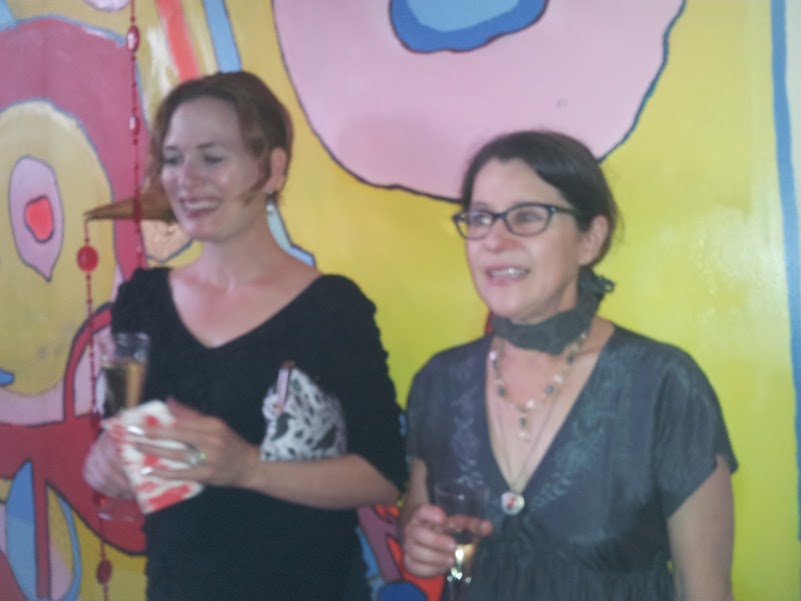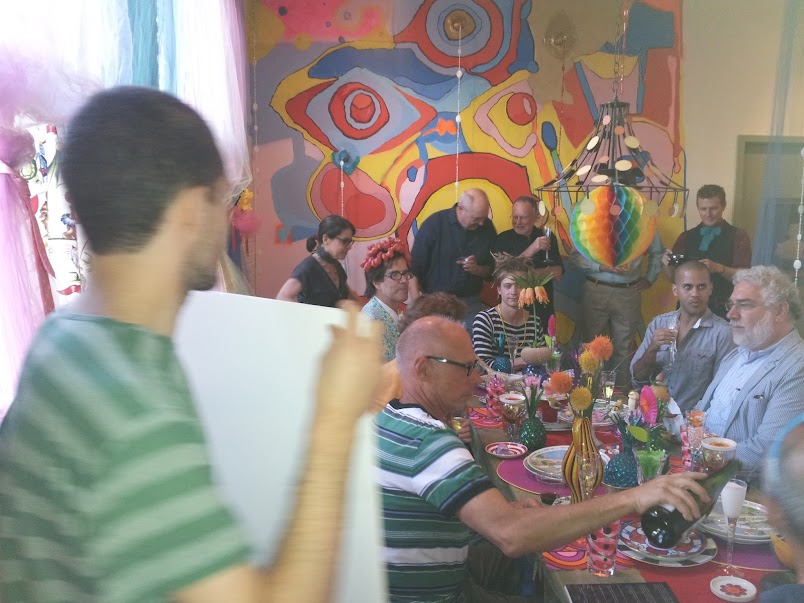Art Counsel
Collections information specialistsArchive for Exhibition concepts
Conceptual Space in Milwaukee
For a last hurrah before remodeling as a more open, streamlined space, the Portrait Society Gallery hosted “A Fop’s Banquet, an Exhibition in Three Acts” last night. For those of you unfamiliar, the gallery is dedicated to exploring the concept and function of portraiture in art – a generally underconsidered genre.
Most worth mentioning is the whimsical “banquet room” where guests were invited to participate as part of the exhibition and in a cleverly organized auction, as well as to observe. A professional photographer took portraits and snapshots throughout the evening in all of the gallery rooms so it will be interesting to see if they translate into a new “hall of mirrors” sort of portraiture exhibition.

Kat Murrell and Debra Brehmer
Owner, Debra Bremer has long been working in a participatory curatorial style (the most notable being the Winter Chapel exhibition) that promises to flower into something increasingly more conceptual with the new layout. I am looking forward to making the trip from Chicago to attend its future functions and Ms. Bremer’s curatorial explorations

“A Fop’s Banquet” auction
.
Musings about the MicroMuseums that are Relational Art (repost)
Since beginning exploration of relational aesthetics, my opinions have been troubled. The difficulty has not been with how to stick it in a box and label it – I am refreshed by the many absurdities that are revealed in the attempt to do so. However, the relational event is curiously indefinite regarding its place in the realm of art production. As a trained curator and archivist, to me many relational events seem like curatorships, and their artifacts, like collections. There is also a scientific strain that while refreshing, often slides quite closely to sociopathic puppeteering. That is not to say that string-pulling is anathema to art, but the strings are palpable, almost visible; and they tend to make the participant rather pathetic.
To explain the sense of pathetique, the development of the happening over time needs to be addressed. The more utopian, earlier attempts such as Beuys’ Bureau for Direct Democracy and even Graciela Carnevale’s Experimental Art Cycle with its goal of violence promised a certain inclusivity and universality, yet remain firmly in control of the artist. The audience is part of the show but voluntarily so; therefore retaining a certain level of dignity regardless of their reaction to the staged relational act. Adrian Piper’s later Notes on Funk still retained a hope for the universal experience, but did not bet on it, as it hinged on post-modern historical revisionist strategy intended to educate on some level. Tiravanija’s Pad Thai, however, was not led nor attended by the artist, and was entirely participant led. Predictably, mostly art scenesters attended. This in itself is perhaps an interesting framing of that momentary state of art and society, and there is no sense that this result was intended, but the outcome was, considering its set-up and marketing, fairly likely. Therefore, while the space between the audience and the author has up to this point been closing, this exhibition marks the distancing of the author from a work which consists of audience – and the artist relinquishes a certain amount of personal responsibility for a human situation that s/he created.
This may appear in some ways to be anti-creative, but it is on the contrary an invitation to Chaos that rather flatly gives way to Predictability. Neither force lacks creative potential, but it does expose that Potential is what drives relational concept-building. Further, relational aesthetics is simply a different philosophy/creativity that allows the non-artist to create consciously or not within a constructed social frame, yet creative potential is limited because the vast majority of people (Western tradition anyway) have a century-old rather polite perception of what art is and should be, so the sense of play can be seen as a game of manipulation rather than an opportunity to step into an authored, limited and temporary “culture” that foregrounds the frames we unconsciously construct for ourselves.
REFERENCES
Participation. Ed. Claire Bishop. London: The MIT Press, 2006. Print.
Conceptually Speaking, Michael Landy’s “Art Bin” scores a big “Meh”
When the promos for Landy’s Art Bin exhibition were first flying around, it seemed truly subversive, but upon learning that he is not destroying “valuable” art but castoffs, which as artistic failures are really only on the edge of what might be called “art”, the concept was quite disappointing. So what? He is putting garbage in a garbage bin. The only remotely interesting thing seems that the garbage of many is collected at a single onsite orgy of artistic self-absorption.
The concept is touted as “a monument to creative failure” and has no apparent connection to current events and concerns. True, Philip Hensher claims that “Landy’s important…because just at this moment we’re slightly disenchanted with money itself, we’re slightly disenchanted with money’s power to act as an aesthetic judgment in itself.” But this seems looking through the telescope backwards. In a time when loss and hardship are commonly felt due to the economy, and in a world where wasting materials is a guilt-ridden experience due to ecological concerns this seems ill-timed. Not that I think these political concerns are intended to be foregrounded here, as the act of destroying rejected art is not on a level with destroying rain forest with intentional Exxon oil spills. If he is going for shock-value or making his bid as the Siva of the art world, it would seem more powerful to destroy things of real and enduring value to someone, as he did in Break Down, though magnified to everyone. Then again, this would merely seem a bit of one-upmanship were he to do so. Though this is mildly different, it seems muted and even a bit lazy.
Where are the famously resonant recontextualizations? Am I missing something? Yeah I get the undercurrent of the “one man’s trash…” proverb and that Landy is not acting as a “judge” and all things are created equal (blah, blah, blah). Sure, there are many who would like to own even the lowliest of castoffs from some of the donating artists, so perhaps one can cull a certain irony in poking fun at those who would be chagrined at the destruction: those who might be considered junkmen collectors; those who find value in artists’ mistakes; the nouveau riche for bad taste… But really, if this is any part of his intention or of the general reaction, how post-modern (zzzzzzz)! Perhaps the ultimate irony is that this appears to be, all-in-all, a throwaway concept by Landy himself.

